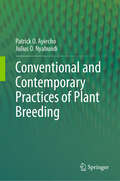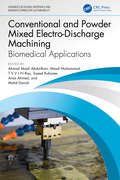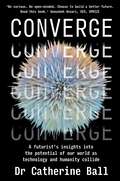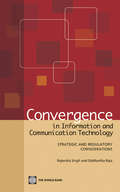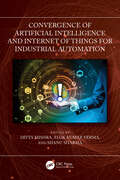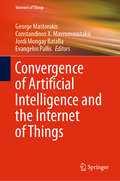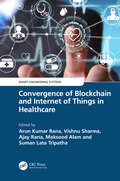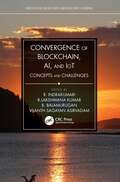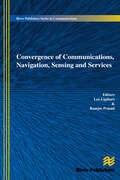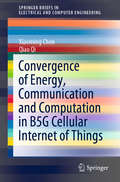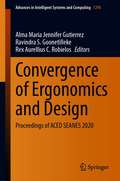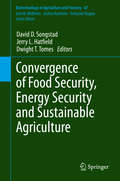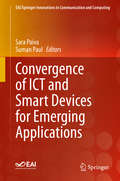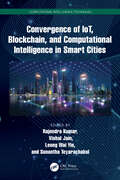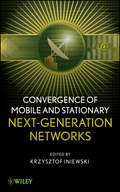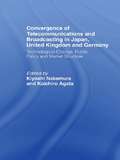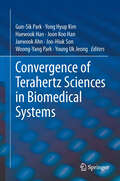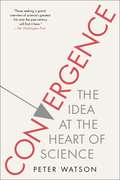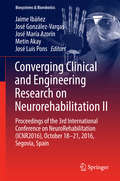- Table View
- List View
Conventional and Contemporary Practices of Plant Breeding
by Patrick O. Ayiecho Julius O. NyabundiThis book covers some established conventional and recent advances in plant breeding methods. It highlights and treats in detail some breeding strategies not adequately handled or usually ignored in many plant breeding texts. There is in-depth coverage of plant resistance mechanisms to various stress factors and application of phenotyping, genotyping, bioinformatics, molecular markers, ‘omics’ technologies, biotechnology, transgenesis and gene editing in crop improvement. Topics like germplasm conservation, plant sex expression and pollination control, recurrent selection methods, interspecific hybridisation, pre-breeding, chromosome manipulation and breeding for resistance to diseases and insect pests are comprehensively covered. The book gives special attention to some problems that affect food security in developing countries, e.g., parasitic weeds and drought and heat stress. Breeding for resistance to parasitic weeds like Striga, broomrapes and Cascuta is always ignored in most plant breeding texts. Where applicable, problems and challenges associated with some breeding strategies are highlighted and possible solutions proposed. The text is rich in relevant examples for various topics. The book is suitable for teaching of plant breeding at the university level and is also beneficial to practising plant breeders. It brings together some relevant work and literary information that is useful to university lecturers, students and practising plant breeders. The book targets university students in agricultural and plant sciences, particularly those taking plant breeding as a key unit/course.
Conventional and Powder Mixed Electro-Discharge Machining: Biomedical Applications (Advances in Design, Materials and Manufacturing for Sustainability)
by Abdul-Rani, Ahmad Majdi Masdi Muhammad Rao, T V V L N Saeed Rubaiee Anas Ahmed Mohd DanishThis book presents the evolution of the electro-discharge machining (EDM) process from conventional EDM to powder mixed EDM with emphases on biomedical applications. It discusses the theory behind each process and their applications in the field of biomedical research, and presents a brief background to various EDM processes, current research challenges, and detailed case studies of powder mixed EDM of various materials. It also includes a state-of-the-art review of the EDM process.Features: Focuses on biomedical implant and device manufacturing using commercialization of powder mixed electro-discharge machining (PM-EDM) technology Discusses surface modification of biomaterials through the PM-EDM process Reviews processing of the metallic biomaterials for biomedical applications Explores optimization of the process factors for achieving optimal responses using NSGA-II Includes comprehensive mechanism and application details of the PM-EDM process This book is aimed at graduate students and researchers in manufacturing, production, materials, and biomedical engineering.
Converge: A futurist's insights into the potential of our world as technology and humanity collide
by Catherine BallMulti-award-winning scientific futurist Dr. Catherine Ball presents insights into how technology and science are providing answers to many of the challenges the world is facing today— food shortages, war and conflict, the decline in local manufacturing, health and ageing, and global warming— and asks why we are not embracing these technologies mo.re widely. The answer in many cases is, 'Because we don't know about them!' Well, now we do. Dr Catherine opens our eyes to the amazing, wide world of technological advancements and explores the role we all have in learning more, owning the conversations, and determining what we want technology to be. What is the role AI can play in the resurgence of local manufacturing and creating new jobs? Can we vaccinate against cancer? How can drones save lives and assist Mother Nature in her fight to stop humans destroying our beloved planet? And how can we utilise the best modern technologies to live longer, healthier, and happier lives? Written with wit, tenacity, and deeply personal experiences, Converge offers an optimistic, in-depth, and fascinating investigation into the possibilities of a world where humans fully embrace technology.
Converged Communications: Evolution from Telephony to 5G Mobile Internet
by Erkki KoivusaloCONVERGED COMMUNICATIONS A one-of-a-kind exploration of the past, present, and future of telecommunications In Converged Communications: Evolution from Telephony to 5G Mobile Internet, telecommunications industry veteran Erkki Koivusalo delivers an essential reference describing how different communications systems work, how they have evolved from fixed telephone networks to the latest 5G mobile systems, and how the voice and data services converged. The central theme of the book is to build deeper understanding about incremental technological progress by introducing both state of the art and their predecessor technologies. The book explores four main areas, including fixed telephone systems, data communication systems, mobile cellular systems, and IP multimedia systems. It clearly explains architectures, protocols, and functional procedures, and discusses a variety of topics ranging from physical layer processes to system level interactions. Converged Communications offers: In-depth treatments of fixed telephone and transmission systems, including operation of telephone exchanges and signaling systems Comprehensive explorations of data communication systems, including transmission of data over telephone lines and data network technologies, such as Ethernet and TCP/IP Incisive discussions of mobile cellular systems, including GSM, 3G, LTE, VoLTE and 5G Insightful analysis of incremental system evolution to justify various design choices made The book is supported with extensive online appendices, which covers communication system concepts, an overview of standardization, various technologies used in the past, state-of-the art technologies such as WLAN, cable modems, and FTTx, complementing the other systems described in the book which have evolved from the fixed telephone network. Perfect for network operators, system integrators, and communication system vendors, Converged Communications: Evolution from Telephony to 5G Mobile Internet will also earn a place in the libraries of undergraduate and graduate students studying telecommunications and mobile systems. Constructive comments and improvement proposals about Converged Communications or its online appendices can be sent by email to address converged.communications.book@gmail.com. The feedback will be considered for possible new editions of the book or the revisions of the appendices.
Convergence in Information and Communication Technology
by Siddhartha Raja Rajendra SinghGrowth in the information and communication technology (ICT) sector has exploded over the past 20 years. Continuous dynamic market and technology developments in this sector have led to a phenomenon known as convergence, which is defined in this volume as the erosion of boundaries between previously separate ICT services, networks, and business practices. Some examples include cable television networks that offer phone service, Internet television, and mergers between media and telecommunications firms. The results are exciting and hold significant promise for developing countries, which can benefit from expanded access, greater competition, and increased investments. However, convergence in ICT is challenging traditional policy and regulatory frameworks. With convergence occurring in countries across the spectrum of economic development, it is critical that policy makers and regulators understand and respond in ways that maximize the benefits while mitigating the risks. This volume analyzes the strategic and regulatory dimensions of convergence. It offers policy makers and regulators examples from countries around the world as they address this phenomenon. The authors suggest that countries that enable convergence are likely to reap the greater rewards, but the precise nature of the response will vary by country. Hence, this book offers global principles that should be tailored to local circumstances as regulatory frameworks evolve to address convergence.
Convergence of Artificial Intelligence and Internet of Things for Industrial Automation
by Divya Mishra Shanu Sharma Alok Kumar VermaThis book begins by discussing the fundamentals of Artificial Intelligence, the Internet of Things, and their convergence. It then covers techniques, algorithms, and methods of analysing and processing data over the Artificial Intelligence of Things. The text elaborates on important concepts such as body sensor networks for safety in smart factories, smart energy management, smart robotic assistive systems, and service-oriented smart manufacturing.This book:• Discusses the security and privacy aspect of Artificial Intelligence of Things (AIoT) for smart real-time applications.• Explores challenges and issues of Artificial Intelligence and the Internet of Things in the field of industrial automation.• Includes case studies in Artificial Intelligence of Things (AIoT) convergence for data processing.• Showcases algorithms, techniques, and methods of analysing and processing data over the Artificial Intelligence of Things.• Highlights operation management using human-robot, smart maintenance, and autonomous production.It will serve as an ideal reference text for senior undergraduate, graduate students, and professionals in fields including industrial engineering, production engineering, manufacturing engineering, operations research, and computer engineering.
Convergence of Artificial Intelligence and the Internet of Things (Internet of Things)
by Constandinos X. Mavromoustakis George Mastorakis Jordi Mongay Batalla Evangelos PallisThis book gathers recent research work on emerging Artificial Intelligence (AI) methods for processing and storing data generated by cloud-based Internet of Things (IoT) infrastructures. Major topics covered include the analysis and development of AI-powered mechanisms in future IoT applications and architectures. Further, the book addresses new technological developments, current research trends, and industry needs. Presenting case studies, experience and evaluation reports, and best practices in utilizing AI applications in IoT networks, it strikes a good balance between theoretical and practical issues. It also provides technical/scientific information on various aspects of AI technologies, ranging from basic concepts to research grade material, including future directions. The book is intended for researchers, practitioners, engineers and scientists involved in the design and development of protocols and AI applications for IoT-related devices. As the book covers a wide range of mobile applications and scenarios where IoT technologies can be applied, it also offers an essential introduction to the field.
Convergence of Blockchain and Internet of Things in Healthcare (Smart Engineering Systems: Design and Applications)
by Arun Kumar Rana, Vishnu Sharma, Ajay Rana, Maksud Alam and Suman Lata TripathiThe Internet of Things (IoT) and blockchain are two new technologies that combine elements in many ways. A system where the virtual and physical worlds interact is created by integrating pervasive computing, ubiquitous computing, communication technologies, sensing technologies, Internet Protocol, and embedded devices. A massive number of linked devices and vast amounts of data present new prospects for developing services that can directly benefit the economy, environment, society, and individual residents. Due to the size of IoT and insufficient data security, security breaches may have a huge impact and negative effects. IoT not only connects gadgets but also people and other entities, leaving every IoT component open to a wide variety of assaults. The implementation and application of IoT and blockchain technology in actual scientific, biomedical, and data applications are covered in this book. The book highlights important advancements in health science research and development by applying the distinctive capabilities inherent to distributed ledger systems. Each chapter describes the current uses of blockchain in real-world data collection, medicine development, device tracking, and more meaningful patient interaction. All of these are used to create opportunities for expanding health science research. This paradigm change is studied from the perspectives of pharmaceutical executives, biotechnology entrepreneurs, regulatory bodies, ethical review boards, and blockchain developers.Key Features: Provides a foundation for the implementation process of blockchain and IoT devices based on healthcare-related technology Image processing and IoT device researchers can correlate their work with other requirements of advanced technology in the healthcare domain Conveys the latest technology, including artificial intelligence and machine learning, in healthcare-related technology Useful for the researcher to explore new things like security, cryptography, and privacy in healthcare related technology Tailored for people who want to start in healthcare-related technology with blockchain and IoT This book is primarily for senior undergraduates, graduate students, and academic researchers in the fields of electrical engineering, electronics and communication engineering, computer science and engineering, and biomedical engineering.
Convergence of Blockchain, AI, and IoT: Concepts and Challenges (Innovations in Big Data and Machine Learning)
by R. IndrakumariConvergence of Blockchain, AI, and IoT: Concepts and Challenges discusses the convergence of three powerful technologies that play into the digital revolution and blur the lines between biological, digital, and physical objects. This book covers novel algorithms, solutions for addressing issues in applications, security, authentication, and privacy. The book provides an overview of the clinical scientific research enabling smart diagnosis equipment through AI. It presents the role these technologies play in augmented reality and blockchain, covers digital currency managed with bitcoin, and discusses deep learning and how it can enhance human thoughts and behaviors. Targeted audiences range from those interested in the technical revolution of blockchain, big data and the Internet of Things, to research scholars and the professional market.
Convergence of Communications, Navigation, Sensing and Services (River Publishers Series In Communications Ser.)
by Ramjee Prasad Leo LigthartActivities on integrated communications, navigation, sensing and services are urgently needed in a wide range of human-centered and/or device-centered system applications. They require a multi-disciplinary approach. It is foreseen that the economic scale of these activities are comparable with the present scale of wireless communications. The area in which systems operate can vary from personal area network to global network.This book covers the following topics;• CONASENSE Architecture• Performance Analyses of Integrated Communication Systems• Cognitive Radio Networks• Brain Computer Interfacing• Quality Improvement of Generic Services• Machine to Machine communications• Chip to Chip CommunicationsThus, the multi-disciplinary approach get attention in the book.
Convergence of Deep Learning and Artificial Intelligence in Internet of Things (Future Generation Information Systems)
by Ahmed A. Elngar Arun Kumar Rana Sharad Sharma Sachin Dhawan Ajay RanaThis book covers advances and applications of smart technologies including the Internet of Things (IoT), artificial intelligence, and deep learning in areas such as manufacturing, production, renewable energy, and healthcare. It also covers wearable and implantable biomedical devices for healthcare monitoring, smart surveillance, and monitoring applications such as the use of an autonomous drone for disaster management and rescue operations. It will serve as an ideal reference text for senior undergraduate, graduate students, and academic researchers in the areas such as electrical engineering, electronics and communications engineering, computer engineering, and information technology. • Covers concepts, theories, and applications of artificial intelligence and deep learning, from the perspective of the Internet of Things. • Discusses powers predictive analysis, predictive maintenance, and automated processes for making manufacturing plants more efficient, profitable, and safe. • Explores the importance of blockchain technology in the Internet of Things security issues. • Discusses key deep learning concepts including trust management, identity management, security threats, access control, and privacy. • Showcases the importance of intelligent algorithms for cloud-based Internet of Things applications. This text emphasizes the importance of innovation and improving the profitability of manufacturing plants using smart technologies such as artificial intelligence, deep learning, and the Internet of Things. It further discusses applications of smart technologies in diverse sectors such as agriculture, smart home, production, manufacturing, transport, and healthcare.
Convergence of Energy, Communication and Computation in B5G Cellular Internet of Things (SpringerBriefs in Electrical and Computer Engineering)
by Xiaoming Chen Qiao QiThis book focuses on the convergence of energy, communication and computation in the beyond 5G (B5G) cellular Internet of Things (IoT). It addresses both theory and techniques, with more weight placed on the latter. This is achieved by providing in-depth studies on a number of major topics such as wireless power transfer, non-orthogonal multiple access, massive multiple-input multiple-output, and over-air computation. In turn, four typical convergence scenarios are studied in detail: the convergence of energy and communication, convergence of energy and computation, convergence of communication and computation, and convergence of energy, communication and computation. The comprehensive and systematic coverage of key techniques in the convergence of energy, communication and computation in the B5G cellular IoT is one of the book’s major features, making it particularly well suited for readers who are interested in learning about practical solutions in B5G wireless networks. Accordingly, the book offers a valuable resource for researchers, engineers, and graduate students in the fields of information engineering, telecommunications engineering, computer engineering, etc.
Convergence of Ergonomics and Design: Proceedings of ACED SEANES 2020 (Advances in Intelligent Systems and Computing #1298)
by Ravindra S. Goonetilleke Alma Maria Jennifer Gutierrez Rex Aurellius C. RobielosThis book presents the proceedings of the Joint Conference of the Asian Council on Ergonomics and Design and Southeast Asian Network of Ergonomics Societies (ACED SEANES), held on December 2-4, 2020. By highlighting the latest theories and models, as well as cutting-edge technologies and applications, and by combining findings from a range of disciplines including engineering, design, robotics, healthcare, management, computer science, human biology and behavioral science, it provides researchers and practitioners alike with a comprehensive, timely guide on human factors and ergonomics. It also offers an excellent source of innovative ideas to stimulate future discussions and developments aimed at applying knowledge and techniques to optimize system performance, while at the same time promoting the health, safety and wellbeing of individuals. The proceedings include papers from researchers and practitioners, scientists and physicians, institutional leaders, managers and policy makers that contribute to constructing the Human Factors and Ergonomics approach across a variety of methodologies, domains and productive sectors.
Convergence of Food Security, Energy Security and Sustainable Agriculture (Biotechnology in Agriculture and Forestry #67)
by Jerry L. Hatfield David D. Songstad Dwight T. TomesThis volume examines the interrelated fields of food security, energy security and sustainable agriculture as the key to a stable global agricultural platform and is arranged in six parts The first part is focused on policy considerations relating to food and energy security and sustainable agriculture The authors from this part include Former Under Secretary of Agriculture Gale Buchanan, Former Under Secretary of Energy Raymond Orbach (Chapter 1), Stephen Hughes, Bryan Moser and William Gibbons (Chapter 2) and Thomas Redick (Chapter 3) Part II addresses soil and water, which are two of the key components in secure and sustainable food production Authors from this part are Jerry Hatfield (Chapter 4) and Mahbub Alam, Sharon Megdal et al. (Chapter 5) The third part covers sustainable and secure food production specifically addressing genetically modified traits in Chapter 6 (James McWilliams) and omega-3 fatty acids in Chapter 7 (Jay Whelan et al. ) Agronomic implications relative to food security and sustainable agriculture are described in Part IV Authors include Ravi Sripada, Pradip Das et al. (Chapter 8), Duska Stojsin, Kevin Matson and Richard Leitz (Chapter 9) and S. H. Lee, David Clay and Sharon Clay (Chapter 10) International sustainable agriculture and food security is addressed in Part V with authors Jeff Vitale and John Greenplate (Chapter 11), Julie Borlaug et al. (Chapter 12) and Sylvester Oikeh et al. (Chapter 13) The final part covers the use of chemicals in sustainable agriculture and food/energy security with Leonard Gianessi and Ashley Williams communicating the role of herbicides and Harold Reetz emphasizing the importance of fertilizers both in maximizing crop yields to maintain a sustainable secure source for food production.
Convergence of ICT and Smart Devices for Emerging Applications (EAI/Springer Innovations in Communication and Computing)
by Sara Paiva Suman PaulThis book focuses on recent topics related to the convergence of information and communication technologies (ICT) and computing with smart devices. Domain areas of application include social, industrial, business development, and day to day life aspects. This book presents chapters related to the aforementioned topics including case studies showcasing future technological trends and challenges. Topics social inclusion solutions and social changes; smart devices and applications for day to day life; smart IoT and applications; and smart cities solutions. The book is applicable to researchers, students, professionals, and professors in a wide range of fields.Focuses on recent developments in ICT and smart devices that pose a clear benefit for users;Presents applications of ICT in education, health, electronics, communication, networking, computing, tourism, transportation;Appeals to researchers, academics, and professionals in a cross section of disciplines.
Convergence of Internet of Things and Blockchain Technologies (EAI/Springer Innovations in Communication and Computing)
by Sam Goundar H L Gururaj V Ravi Kumar Ahmed A Elngar B H SwathiThis book presents chapters from diverse range of authors on different aspects of how Blockchain and IoT are converging and the impacts of these developments. The book provides an extensive cross-sectional and multi-disciplinary look into this trend and how it affects artificial intelligence, cyber-physical systems, and robotics with a look at applications in aerospace, agriculture, automotive, critical infrastructures, healthcare, manufacturing, retail, smart transport systems, smart cities, and smart healthcare. Cases include the impact of Blockchain for IoT Security; decentralized access control systems in IoT; Blockchain architecture for scalable access management in IoT; smart and sustainable IoT applications incorporating Blockchain, and more. The book presents contributions from international academics, researchers, and practitioners from diverse perspectives.Presents how Blockchain and IoT are converging and the impacts of these developments on technology and its application;Discusses IoT and Blockchain from cross-sectional and multi-disciplinary perspectives;Includes contributions from researchers, academics, and professionals from around the world.
Convergence of IoT, Blockchain, and Computational Intelligence in Smart Cities (Computational Intelligence Techniques)
by Rajendra Kumar Vishal Jain Leong Wai Yie Sunantha TeyarachakulThis edited book presents an insight for modelling, procuring, and building the smart city plan using the Internet of Things (IoT) and a security framework using blockchain technology. The applications of Li-Fi and 5G in smart cities are included, along with their implementation, challenges, and advantages. This book focuses on the use of IoT and blockchain in the day-to-day transparent and recorded activities of citizens of smart cities like, smart citizen management. The future for upgrading the system as per technological advancements is also discussed. This book: integrates IoT, blockchain, Li-Fi, and 5G in smart city implementation covers smart supply chain management using IoT outlines the state-of-the-art and sustainable implementation of smart cities and practical challenges includes sustainable development of smart cities presents detailed explanation of case studies of smart cities of developed countries and developing countries and their comparisons This book is aimed at researchers and graduate students in Artificial Intelligence, Urban Planning, and Information Technology Systems and Management.
Convergence of Mobile and Stationary Next-Generation Networks
by Krzysztof IniewskiThe Only Resource to Cover Wireless, Wireline, and Optical Networks in One VolumeMobile and stationary next-generation networks that access the photonic core are destined to become as ubiquitous as traditional telephone networks. These networks must efficiently provide adequate network quality to multimedia applications with high bandwidth and strict quality-of-service requirements, as well as seamlessly integrate mobile and fixed architectures. Today's engineering students must be properly prepared to meet the challenges of next-generation network development and deployment.Featuring contributions from top industrial experts and academic professors, this authoritative work provides a comprehensive introduction to next-generation networks. It explains wireless networks such as wireless local area networks (WLAN), wireless personal area networks (WPAN), wireless access, 3G/4G cellular, and RF transmission, as well as optical networks like long-haul and metropolitan networks, optical fiber, photonic devices, and VLSI chips. Rather than focusing on heavy math or physical details, this resource explores how the technology is being used. It describes access and transport network layer technologies while also discussing the network and services aspects.Chapter coverage includes:Fiber-wireless networks: technologies, architectures, and future challengesPacket backhaul networkPoint-to-point microwave backhaulFourth-generation broadband: paving the road to Gbit/s with copperDynamic bandwidth allocation in EPON and GPONNext-generation ethernet passive optical networks: 10G-EPONPower line communications and smart gridsSignaling for multimedia conferencing in 4G: architecture, evaluation, and issuesSelf-coexistence and security in cognitive radio networksMobile WiMAXUWB personal area networks--MIMO extensionsNext-generation integrated metropolitan-access network: technology integration and wireless convergenceResilient burst ring: a novel technology for the next-generation metropolitan area networksFilled with illustrations and practical examples from industry, this book will be invaluable to engineers and researchers in industry and academia, as well as senior undergraduate and graduate students, marketing and management staff, photonics physicists, and chip designers.
Convergence of Telecommunications and Broadcasting in Japan, United Kingdom and Germany: Technological Change, Public Policy and Market Structure
by Koichiro Agata Kiyoshi NakamuraThe convergence of telecommunications and broadcasting raises many questions. What form will convergence take in the future? When convergence produces new opportunities in the information, education and entertainment markets, what sort of rules of the game will be required? How will the players behave in these new markets? What policies might be needed?
Convergence of Terahertz Sciences in Biomedical Systems
by Gun-Sik Park Haewook Han Jaewook Ahn Joo-Hiuk Son Joon Koo Han Woong-Yang Park Yong Hyup Kim Young Uk JeongRecent technological breakthrough in the field of Terahertz radiation has triggered new applications in biology and biomedicine. Particularly, biological applications are based on the specific spectroscopic fingerprints of biological matter in this spectral region. Historically with the discovery of new electromagnetic wave spectrum, we have always discovered new medical diagnostic imaging systems. The use of terahertz wave was not realized due to the absence of useful terahertz sources. Now after successful generation of THz waves, it is reported that a great potential for THz wave exists for its resonance with bio-molecules. There are many challenging issues such as development of THz passive and active instrumentations, understanding of THz-Bio interaction for THz spectroscopy, THz-Bio nonlinear phenomena and safety guideline, and THz imaging systems. Eventually the deeper understanding of THz-Bio interaction and novel THz systems enable us to develop powerful THz biomedical imaging systems which can contribute to biomedical industry. This is a truly interdisciplinary field and convergence technology where the communication between different disciplines is the most challenging issue for the success of the great works. One of the first steps to promote the communications in this convergence technology would be teaching the basics of these different fields to the researchers in a plain language with the help of Convergence of Terahertz Science in Biomedical Systems which is considered to be 3-4th year college students or beginning level of graduate students. Therefore, this type of book can be used by many people who want to enter or understand this field. Even more it can be used for teaching in universities or research institutions.
Convergence: The Idea at the Heart of Science
by Peter WatsonA brilliant history of science over the past 150 years that offers a powerful new argument—that the many disparate scientific branches are converging on the same truths.Convergence is a history of modern science with an original and significant twist. Various scientific disciplines, despite their very different beginnings, have been coming together over the past 150 years, converging and coalescing. Intimate connections have been discovered between physics and chemistry, psychology and biology, genetics and linguistics. In this groundbreaking book, Peter Watson identifies one extraordinary master narrative, capturing how the sciences are slowly resolving into one overwhelming, interlocking story about the universe. Watson begins his narrative in the 1850s, the decade when, he argues, the convergence of the sciences began. The idea of the conservation of energy was introduced in this decade, as was Darwin’s theory of evolution—both of which rocketed the sciences forward and revealed unimagined interconnections and overlaps between disciplines. The story then proceeds from each major breakthrough and major scientist to the next, leaping between fields and linking them together. Decade after decade, the story captures every major scientific advance en route to the present, proceeding like a cosmic detective story, or the world’s most massive code-breaking effort. Watson’s is a thrilling new approach to the history of science, revealing how each piece falls into place, and how each uncovers an “emerging order.” Convergence is, as Nobel Prize-winning physicist Steven Weinberg has put it, “The deepest thing about the universe.” And Watson’s comprehensive and eye-opening book argues that all our scientific efforts are indeed approaching unity. Told through the eyes of the scientists themselves, charting each discovery and breakthrough, it is a gripping way to learn what we now know about the universe and where our inquiries are heading.
Converging Clinical and Engineering Research on Neurorehabilitation II: Proceedings of the 3rd International Conference on NeuroRehabilitation (ICNR2016), October 18-21, 2016, Segovia, Spain (Biosystems & Biorobotics #15)
by Metin Akay José González-Vargas Jaime Ibáñez José Luis Pons José María AzorínThe book reports on advanced topics in the areas of neurorehabilitation research and practice. It focuses on new methods for interfacing the human nervous system with electronic and mechatronic systems to restore or compensate impaired neural functions. Importantly, the book merges different perspectives, such as the clinical, neurophysiological, and bioengineering ones, to promote, feed and encourage collaborations between clinicians, neuroscientists and engineers. Based on the 2016 International Conference on Neurorehabilitation (ICNR 2016) held on October 18-21, 2016, in Segovia, Spain, this book covers various aspects of neurorehabilitation research and practice, including new insights into biomechanics, brain physiology, neuroplasticity, and brain damages and diseases, as well as innovative methods and technologies for studying and/or recovering brain function, from data mining to interface technologies and neuroprosthetics. In this way, it offers a concise, yet comprehensive reference guide to neurosurgeons, rehabilitation physicians, neurologists, and bioengineers. Moreover, by highlighting current challenges in understanding brain diseases as well as in the available technologies and their implementation, the book is also expected to foster new collaborations between the different groups, thus stimulating new ideas and research directions.
Converging Clinical and Engineering Research on Neurorehabilitation III: Proceedings of the 4th International Conference on NeuroRehabilitation (ICNR2018), October 16-20, 2018, Pisa, Italy (Biosystems & Biorobotics #21)
by Metin Akay José L. Pons Lorenzo Masia Silvestro MiceraThe book reports on advanced topics in the areas of neurorehabilitation research and practice. It focuses on new methods for interfacing the human nervous system with electronic and mechatronic systems to restore or compensate impaired neural functions. Importantly, the book merges different perspectives, such as the clinical, neurophysiological, and bioengineering ones, to promote, feed and encourage collaborations between clinicians, neuroscientists and engineers. Based on the 2018 International Conference on Neurorehabilitation (ICNR 2018) held on October 16-20, 2018, in Pisa, Italy,, this book covers various aspects of neurorehabilitation research and practice, including new insights into biomechanics, brain physiology, neuroplasticity, and brain damages and diseases, as well as innovative methods and technologies for studying and/or recovering brain function, from data mining to interface technologies and neuroprosthetics. In this way, it offers a concise, yet comprehensive reference guide to neurosurgeons, rehabilitation physicians, neurologists, and bioengineers. Moreover, by highlighting current challenges in understanding brain diseases as well as in the available technologies and their implementation, the book is also expected to foster new collaborations between the different groups, thus stimulating new ideas and research directions.
Converging Clinical and Engineering Research on Neurorehabilitation IV: Proceedings of the 5th International Conference on Neurorehabilitation (ICNR2020), October 13–16, 2020 (Biosystems & Biorobotics #28)
by Metin Akay Diego Torricelli Jose L. PonsThe book reports on advanced topics in the areas of neurorehabilitation research and practice. It focuses on new methods for interfacing the human nervous system with electronic and mechatronic systems to restore or compensate impaired neural functions. Importantly, the book merges different perspectives, such as the clinical, neurophysiological, and bioengineering ones, to promote, feed and encourage collaborations between clinicians, neuroscientists and engineers. Based on the 2020 International Conference on Neurorehabilitation (ICNR 2020) held online on October 13-16, 2020, this book covers various aspects of neurorehabilitation research and practice, including new insights into biomechanics, brain physiology, neuroplasticity, and brain damages and diseases, as well as innovative methods and technologies for studying and/or recovering brain function, from data mining to interface technologies and neuroprosthetics. In this way, it offers a concise, yet comprehensive reference guide to neurosurgeons, rehabilitation physicians, neurologists, and bioengineers. Moreover, by highlighting current challenges in understanding brain diseases as well as in the available technologies and their implementation, the book is also expected to foster new collaborations between the different groups, thus stimulating new ideas and research directions.
Converging Clinical and Engineering Research on Neurorehabilitation V: Proceedings of the 6th International Conference on Neurorehabilitation (ICNR 2024), November 5–8, 2024, La Granja, Spain - Volume 1 (Biosystems & Biorobotics #31)
by Metin Akay Jose L. Pons Jesus TorneroThe book reports on advanced topics in the areas of neurorehabilitation research and practice. It focuses on new methods for interfacing the human nervous system with electronic and mechatronic systems to restore or compensate impaired neural functions. Importantly, the book merges different perspectives, such as the clinical, neurophysiological, and bioengineering ones, to promote, feed and encourage collaborations between clinicians, neuroscientists and engineers. Based on the 2024 International Conference on Neurorehabilitation (ICNR2024) held in La Granja, Spain on November 5-8, 2024, this book covers various aspects of neurorehabilitation research and practice, including new insights into biomechanics, brain physiology, neuroplasticity, and brain damages and diseases, as well as innovative methods and technologies for studying and/or recovering brain function, from data mining to interface technologies and neuroprosthetics. In this way, it offers a concise, yet comprehensive reference guide to neurosurgeons, rehabilitation physicians, neurologists, and bioengineers. Moreover, by highlighting current challenges in understanding brain diseases as well as in the available technologies and their implementation, the book is also expected to foster new collaborations between the different groups, thus stimulating new ideas and research directions.
